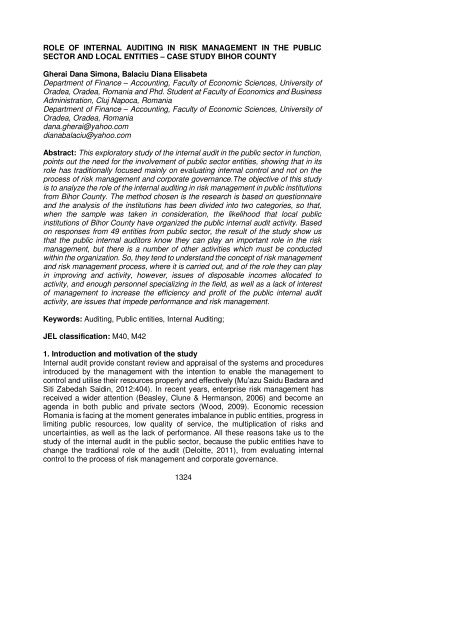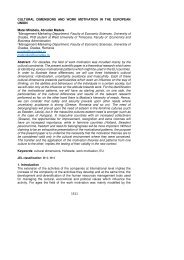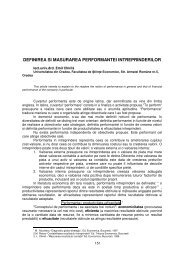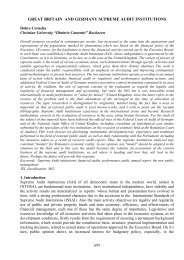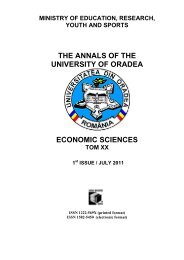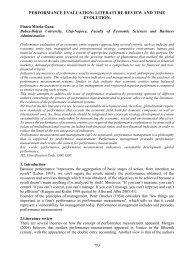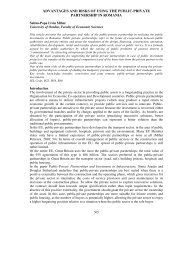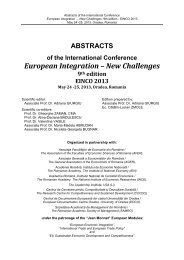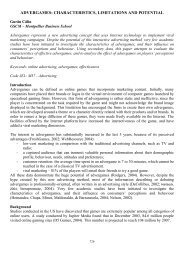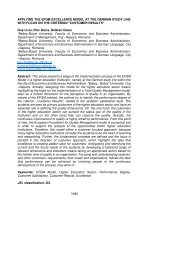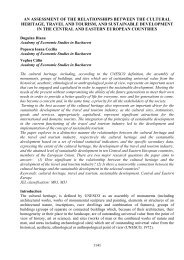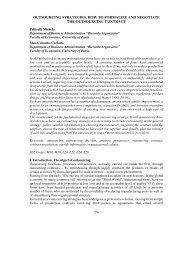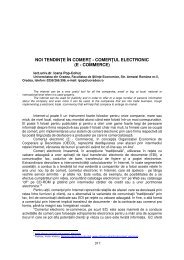1324 ROLE OF INTERNAL AUDITING IN RISK MANAGEMENT IN ...
1324 ROLE OF INTERNAL AUDITING IN RISK MANAGEMENT IN ...
1324 ROLE OF INTERNAL AUDITING IN RISK MANAGEMENT IN ...
You also want an ePaper? Increase the reach of your titles
YUMPU automatically turns print PDFs into web optimized ePapers that Google loves.
<strong>ROLE</strong> <strong>OF</strong> <strong><strong>IN</strong>TERNAL</strong> <strong>AUDIT<strong>IN</strong>G</strong> <strong>IN</strong> <strong>RISK</strong> <strong>MANAGEMENT</strong> <strong>IN</strong> THE PUBLICSECTOR AND LOCAL ENTITIES – CASE STUDY BIHOR COUNTYGherai Dana Simona, Balaciu Diana ElisabetaDepartment of Finance – Accounting, Faculty of Economic Sciences, University ofOradea, Oradea, Romania and Phd. Student at Faculty of Economics and BusinessAdministration, Cluj Napoca, RomaniaDepartment of Finance – Accounting, Faculty of Economic Sciences, University ofOradea, Oradea, Romaniadana.gherai@yahoo.comdianabalaciu@yahoo.comAbstract: This exploratory study of the internal audit in the public sector in function,points out the need for the involvement of public sector entities, showing that in itsrole has traditionally focused mainly on evaluating internal control and not on theprocess of risk management and corporate governance.The objective of this studyis to analyze the role of the internal auditing in risk management in public institutionsfrom Bihor County. The method chosen is the research is based on questionnaireand the analysis of the institutions has been divided into two categories, so that,when the sample was taken in consideration, the likelihood that local publicinstitutions of Bihor County have organized the public internal audit activity. Basedon responses from 49 entities from public sector, the result of the study show usthat the public internal auditors know they can play an important role in the riskmanagement, but there is a number of other activities which must be conductedwithin the organization. So, they tend to understand the concept of risk managementand risk management process, where it is carried out, and of the role they can playin improving and activity, however, issues of disposable incomes allocated toactivity, and enough personnel specializing in the field, as well as a lack of interestof management to increase the efficiency and profit of the public internal auditactivity, are issues that impede performance and risk management.Keywords: Auditing, Public entities, Internal Auditing;JEL classification: M40, M421. Introduction and motivation of the studyInternal audit provide constant review and appraisal of the systems and proceduresintroduced by the management with the intention to enable the management tocontrol and utilise their resources properly and effectively (Mu’azu Saidu Badara andSiti Zabedah Saidin, 2012:404). In recent years, enterprise risk management hasreceived a wider attention (Beasley, Clune & Hermanson, 2006) and become anagenda in both public and private sectors (Wood, 2009). Economic recessionRomania is facing at the moment generates imbalance in public entities, progress inlimiting public resources, low quality of service, the multiplication of risks anduncertainties, as well as the lack of performance. All these reasons take us to thestudy of the internal audit in the public sector, because the public entities have tochange the traditional role of the audit (Deloitte, 2011), from evaluating internalcontrol to the process of risk management and corporate governance.<strong>1324</strong>
It used to be that internal auditing in the public sector served as a simpleadministrative procedure comprised mainly of checking accuracy of transactions,pre-payment verification and control, counting assets and reporting on past eventsto various types of management, but in recent times, governments moving towardhigher levels of transparency must demonstrate accountability in the use of publicmoney and efficiency in the delivery of services. Larger and more complexoperations demand greater competency and professionalism from internal auditorsto minimize and manage risk (Deloitte, 2011).In Belgia, Sarens G. et all (2010) makes an analysis that provides an in-depthanalysis of risk management and internal control practices within Belgian socialsecurity public institutions (sspi). The findings show that: risk management andinternal control are not highly developed; internal control is more developed than riskmanagement; and risk management concepts like risk identification and evaluationare part of internal control, rather than internal control being part of risk management.Also concluded the fact that the traditional internal control philosophy (focusing onconformance) is more wide-spread than the recent risk management philosophy(focusing on performance) could be a reason why the performance requirements ofthe SSPI are not met.With respect to internal audit's involvement in the identification and assessment ofrisks in the local public sector and public institutions, Ernst& Young (2008) hasachieved a relevant study on a sample of 400 local authorities and 125 publicinstitutions. The study was based on the questionnaire which was sent to theseentities and had questions about the governance of the public sector, the trends oforganizations with regard to the risks and identify significant areas, the stage ofimplementation of internal control. The answers about the responsibilities of theinternal audit were the following:Table 1 The activities of the internal audit function in the public sector entitiesand public global institutions.Types of activitiesEvaluation of internalcontrolTesting the effectivenessof proceduresPublic institutionsSystematically%1325Often %Local public sectorSystematically%Often %47 32 20 4440 30 17 44Risk identification 32 16 6 27The audit of the financialstatementsAudit of informationsystemsAudit of subordinateentities26 42 15 4325 38 8 2213 31 41 38Formulating procedures 5 26 25 43
Types of activitiesPublic institutionsSystematically%Often %Local public sectorSystematically%Often %Evaluation of publicpoliciesThe consistency ofinternal controlSource: Ernst & Young (2008)- 6 21 36- 21 6 26The survey shows that the identification and assessment of weak points in terms ofrisks is subject to regular internal audit assignments in a percentage of 32% in publicinstitutions and local entities, 6% in the public sector. Also testing the effectivenessof auditing procedures, information systems, and financial information are rarelysubject to public internal audit missions, and missions with an indirect internal audit(writing manuals of procedures, internal consistency checks) are often subject tochoice. The assessment of the internal control and audit of subordinated entitiesabout the systematic and common responsibilities of the internal audit in most ofpublic entities (79%, 64%, 42%, 79%), demonstrates that the internal auditassignments are still traditional.Another poll conducted by Deloitte (2009) shows improper risk management in thepublic sector. The survey was conducted in 200 government departments in 28States, according to officials, 48 percent of the public believes that the world of riskmanagement is one of many challenges met by the financial departments of publicentities.The implementation of relatively recent internal audit in the public sector in Romaniaand financial resources will decline in economic conditions, leading to the premiseto conduct an empirical study to identify to what extent public audit, there areparticipating, improves and helps to smooth risk management in public entities inRomania.Therefore, regarding the previous researches (Rudasingwa Justin, 2006; Mu’azuSaidu Badara and Siti Zabedah Saidin, 2012) we proposed as objective the analysisof the role of internal audit in risk management of the local public institutions in BihorCounty.The analysis was conducted in order to obtain information regarding:• The internal auditor's role in risk management (Anuntaakalakul A., 2010);• The activities undertaken with regard to risk management and the internal audit riskmanagement (IIA, 2011);• The role of public audit on the identification and assessment of risks (Ahmad N. etall, 2009);• Internal audit skills to cope with the development of risk management (MatthewLeitch, 2004);• Lack of motivation activities relating to internal audit and risk management (IIA,2011).We believe that all replies to questionnaires being released, would help us to forman opinion on the role of internal audit in public institutions and risk management,and to determine the reasons for these processes are not carried out.1326
The study undertaken focused on public institutions that operate locally and use ofpublic financial resources. Local government institutions are taken into account inour analysis are those in the Bihor County, the County Council and town councils ofmunicipalities, towns and communes, that the law derives income and use budgetaryappropriations.2. Research methodologyThe objective of our study is to analyze the role of the internal auditing in riskmanagement in public institutions, at local level. As the current research, there hasbeen a positive-type research, and in doing so (Ionaşcu I., 2003:76) the positiveapproach in accounting assumes that any theoretical formulation cannot be validunless it is verified empirically, by confronting the hypothesis with the facts.The method chosen in the research is based on questionnaire, and Francois deSingly (1998:21) states that the survey-based questionnaire serves the explanatorydata, and as a form of research we opted for the statistical survey.3. The construction and presentation of sample reviewThe analysis of the institutions has been divided into two categories, so that, whenthe sample was taken in consideration, the likelihood that local public institutions ofBihor County have organized the public internal audit activity.From the analysis of the sites linked to the Mayor's and the Board of Auditors 'Bihorreport on 2010, we found that public internal audit activity at the level of municipalitiesis not organized in the form of individual departments, it unfolds as an outsourced.So, using a single questionnaire for both categories of institutions that do not providerelevant answers and would have hindered the process of gathering information,which we consider relevant to their classification depending on the organization ofpublic internal audit division.As a result, the sample is comprised of two categories of institutions:• class I, consisting of the County Council and town councils of municipalities inBihor: Oradea, Beiuş, Salonta and Marghita; and the mayoralties of cities in BihorCounty, namely: Aleşd, Nucet, Săcueni, Stei, Valea lui Mihai and Vaşcău; a total of11 entities;• class II, consisting of the municipalities of the 91 municipalities found in the County.The data are recorded and reported by the Directorate General of public financesBihor, and the sample chose a representative geographical distribution. For the twocategories of institutions we have realized 2 questionnaire containing questionsrelevant to the work of risk management in the context of public internal audit divisionand the respondents are internal auditors of public employees in selected publicinstitutions (where there is organized the public internal audit office) and unemployedpeople in the management of institutions (where the public external audit service isoutsourced). The questionnaires were sent electronically and listed.As a result of the questionnaire, we obtained a total number of 49 responses,representing a response rate of 48.03 %. By clicking on the two distributioncategories, the response rate for the first category is 100%, and for category II theresponse rate is of 41.75 %.The non-response rate is higher than that of theresponses and we think the reasons are the lack of system of public internal audit,including outsourced, or negative perceptions, distrust, on opinion polls.4.Analysis of the collected data1327
The sample size is 102 territorial and administrative units and their distribution arepresented as evidenced by the following graph:Graph 1. Distribution of administrative territorial unitsSource: projection made by the author10090807060504030201001 1 4 4 6 69138U.A.T. TotalU.A.T. SurveyedSource: projection made by the authorFrom the point of view of the internal audit division, common question for bothcategories of respondents, of total institutions surveyed 10.2% declare thatorganized public internal audit and it activities that include the control, the controlenvironment, risk assessment and monitoring. The rest of 89.79% institutionsperforming public internal audit as outsourced service.Graph. 2 The degree of organization of public internal auditTotal institutions surveyed54944102The respondent institutionsInstitutions that haveorganized I.P.AInstitutions that have notorganized I.P.ASource: projection made by the author1328
For the first category of respondents, the questions were focused on the role ofinternal audit in public in current business practices and activities for the process ofrisk management, counseling and support granted by the audit reports on theimplementation of the process improvement and performance increase.As a result of the questionnaire, all 5 of the first entity category indicated that theinternal audit activity, the public has had responsibility for implementing riskmanagement, reflecting an active role in the learning process of the management torespond to existing risks (80%) and for the identification and assessment of risks(80%). However, only 66.6% offering independent on the process of riskmanagement, and on the advisory role, it seems that the public internal auditors tendto understand well enough to see the risk management implementation process.Graph. 3 Description of the role of public internal audit risk managementImplementation of riskmanagementIndependent assuranceRisk management consultant000111345Future roleNo roleCurrent role0 1 2 3 4 5Source: projection made by the authorAmong the shortcomings identified in the analysis, they could identify the sufficientrevenue or funds available and the specialist personnel. In all entities, public internalaudit work was carried out with 1-2 auditors, which according to the questionnaireapplied requires knowledge of the practices and techniques of management of riskmanagement. The problem of the lack of personnel in the field of public internal auditat the national level is reflected in the local plan generated by the current economicsituation of our country and blocking positions in the public domain as well.Graph 4. Problems encountered by the public internal auditors:1329
321 Inappropriately budget5The need for personal5Lack of skillLack of coordinationSource: projection made by the authorAs for the second category of entities considered for the analysis undertaken, out of91 from mayoraltiesin records, we achieved a number of 38 replies. The responserate is of 41.75% and respondents are persons or institutions in the FinanceDepartment, so the answers can be considered relevant to the analysis.The municipalities surveyed all declared that the work of the public internal audit inthe form of outsourced service, orunder contractual form. Excluding non-responserate, an increase in the level of activity of internal audit in public administration, inone form or another, and as the regulations require, the local public entities whichhave not set up their own internal audit department or have not been in cooperationto ensure that the internal audit activity it may be provided by the internal auditorsqualified individuals on the basis of contracts for the provision of services, inaccordance with the provisions of the law of 2002 on the audit of 672/public,republished in 2011.At the same time, however, it can be seen that public institutions were not consideredappropriate to amend the article 24 in the law 273/2006 on local public finances onthe formalization of possibility of association of local public institutions, for theorganization and conduct of internal audit, through the county structures with legalpersonality of associative structures of local public administration authorities,recognised as being of public utility or development associations established inaccordance with the law of intercommunity, existed at the level of the institutionssurveyed no association of its kind.1330
Graph. 5 Form of organisation of public internal audit10080604020091383800Public institutions surveyedThe mayors surveyedReplies receivedOffice of public internalauditAudit of the contractualbasisAssociations between themayorsSource: projection made by the authorWith regard to the organization of a future office of public internal audit, only oneinstitution has expressed the willingness to hold a certain office, while only possible52.63% consider this opportunity, arguing the lack of staff and a budget.Graph. 6 Intitutions wishing organizing an own office of public internal audit202018161412108642091Public institutions located8Yes, in the near futureYes, no concrete plansPossibleDefinitely notSource: projection made by the authorTaking into consideration the risk management, over 13% of the analysed institutionsargue that it is in an advanced stage of development, 37% are in the process ofimplementing or has been recently adopted, and the rest do not carry out activitiesspecific to the risk management process.1331
Of the interviewed institutions, in 60% of cases, the liability risk managementbelongs to a risk officer and the remainder belongs to a person who has other duties.ConclusionsWe examine the role of internal auditing in risk management in the public sector fromthe local entities of Bihor county and we find that the activities of the public sector,as well as in the private sector are becoming increasingly more complex due to thenews that appear and the risks they face. Organizations providing risk managementincreasing attention, but implementing an effective risk management requires timeand knowledge.We also document that the public internal auditors know they can play an importantrole in the management of risk, but there is a number of other activities which mustbe conducted within the organization. So, they tend to understand the concept of riskmanagement and risk management process, where it is carried out, and of the rolethey can play in improving and activity, however, issues of disposable incomesallocated to activity, and enough personnel specializing in the field, as well as a lackof interest of management to increase the efficiency and profit of the public internalaudit activity, are issues that impede performance and risk management.The limitation of the paper concerns the analysis of a single county, and the rate ofrespondents. For future research we should validate our findings by extending thereview in other counties of Romania. Likewise, future research should look at thepossibility of inserting institutions that use internal audit from private sector, makinga comparison between the two sectors.ReferencesAhmad, N., Othman, R. & Jusoff, K. (2009). The effectiveness of internal audit inMalaysian public sector. Journal of Modern Accounting and Auditing, 5(9), 784-790.Anuntaakalakul, A. (2010). The achievement in risk management and governanceof public sector organizations in Thailand: The Empirical Evidence of InternalAuditing efforts. EABR & ETLC Conference Proceedings Dublin, Ireland, 99 –104.Beasley, M. S., Clune, R. & Hermanson, D. R. (2006). The impact of enterprise riskmanagement on the internal audit function. Institute of Internal Auditors (IIA)Research Foundation and the assistance. 1- 28.Deloitte, (2009). Financial departments are fighting to accomplish the needs of thepublic sector, available on the website www.deloitte.com/view/ro_RO/ro/index.htmDeloitte, (2011). Internal audit in the public sector. The quiet revolution, available onthe website: http://www.deloitte.comDirecția Generală a Finanțelor Publice Bihor - http://dgfpbh.rdsor.ro/Ernst, Young (2008). Risk management and internal control into the public sectorParis, available on the website www.ey.com/fr/secteurpublicIIA. The Institute of Internal Auditors, (2011). Internal Auditing’s Role in RiskManagement, available on the websitehttp://www.oracle.com/us/solutions/corporate-governance/ia-role-in-rm-345774.pdfIonașcu I. (2003), Dinamica doctrinelor contabile contemporane, Editura Economică,București.Matthew Leitch, (2004). Embedded risk management: the auditors’ contributionInternal control and audit skills development, available on the website:http://www.internalcontrolsdesign.co.uk/embedded/index.shtml1332
Mu’azu Saidu Badara and Siti Zabedah Saidin, (2012). The Relationship betweenRisk Management and Internal Audit Effectiveness at Local Government Level.Journal of Social and Development Sciences, Malaysia v.3, n.12, pp. 404-411http://www.ifrnd.org/admin/jsds/27.pdfRudasingwa Justin, (2006). The role of the internal audit function in enhancing riskmanagement in the Rwanda Social Security Fund (RSSF) available on the websitehttp://libserv5.tut.ac.za:7780/pls/eres/wpg_docload.download_file?p_filename=F1276637603/Rudasingwa.pdfRaportul public pe anul 2010, (2012) – Curtea de Conturi, România, available onlineat: http://www.curteadeconturi.ro/sites/ccr/RO/Publicatii/default.aspx1333


